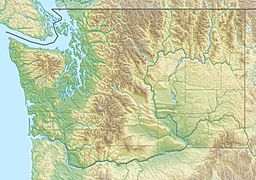Breccia Peak (Washington) facts for kids
Quick facts for kids Breccia Peak |
|
|---|---|
| Highest point | |
| Elevation | 6,487 ft (1,977 m) |
| Prominence | 1,047 ft (319 m) |
| Geography | |
| Location | Glacier Peak Wilderness Snohomish County, Washington, U.S. |
| Parent range | Cascade Range |
| Topo map | USGS Sloan Peak |
| Type of rock | Breccia |
| Climbing | |
| Easiest route | Scramble South Ridge |
Breccia Peak is a cool mountain in the North Cascades range. It is found in Snohomish County, Washington state, in the U.S.. The top of the mountain is about 6,487 feet (1,977 meters) above sea level.
This peak is what's left of an old stratovolcano, which is a type of tall, cone-shaped volcano. It gets its name from the rock it's made of, called breccia. Breccia is a rock made of broken pieces of minerals or other rocks stuck together.
Breccia Peak is located about 15 miles southeast of Darrington, Washington. It is also about 8.7 miles (14 km) west of Glacier Peak. Glacier Peak is another large volcano in the Cascade Mountains. Breccia Peak is part of the beautiful Glacier Peak Wilderness area. This land is managed by the Mount Baker-Snoqualmie National Forest. The closest taller mountain is Mount Pugh, which is about 3.5 miles (5.6 km) to the northwest. Rain and melted snow from Breccia Peak flow into streams that lead to the Sauk River.
Weather Around Breccia Peak
Breccia Peak is in a special weather area called the marine west coast climate zone. This means it gets a lot of moisture from the Pacific Ocean. Most of the weather systems start over the Pacific Ocean. They then move northeast towards the Cascade Range.
When these weather systems hit the tall Cascade Mountains, they are forced to rise. As the air rises, it cools down and drops its moisture. This creates a lot of rain or snowfall on the western side of the mountains. This process is called Orographic lift. Because of this, the western North Cascades get a lot of precipitation, especially snow in winter.
The climate here is mild because it's close to the ocean. Temperatures rarely go below 0°F (–18°C) in winter. They also rarely go above 80°F (27°C) in summer. Winters are usually cloudy. But in summer, high pressure systems over the Pacific Ocean often bring clear, sunny skies. The snow here tends to be wet and heavy. This can sometimes lead to a high risk of avalanches.
How Breccia Peak Formed
The North Cascades mountains have very rugged and dramatic shapes. You can see sharp peaks, long ridges, and deep valleys carved by glaciers. Many millions of years ago, big geological events shaped this area. These events created the tall mountains and deep valleys we see today. They also caused the different climates and plant life in the region.
The Cascade Mountains started forming millions of years ago, during the late Eocene Epoch. This was a time when the North American Plate was slowly moving over the Pacific Plate. This movement caused a lot of volcanic activity, creating many volcanoes. Also, small pieces of the Earth's crust, called terranes, crashed into North America. These collisions helped build the North Cascades about 50 million years ago.
Later, during the Pleistocene period, which began over two million years ago, huge glaciers covered the land. These glaciers moved forward and then melted back many times. As they moved, they scraped and carved the landscape. They left behind piles of rock and debris. The "U"-shaped valleys you see today were formed by these powerful glaciers. The main forces that created the tall peaks and deep valleys of the North Cascades were uplift (when land is pushed up) and faulting (when cracks form in the Earth's crust). These forces, combined with glaciation, shaped the mountains.



